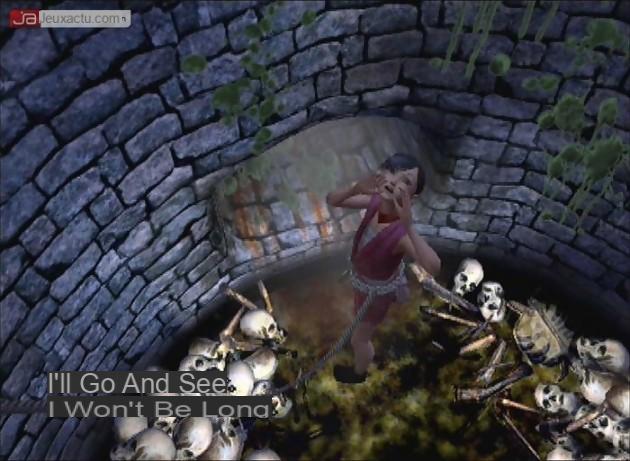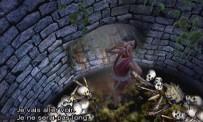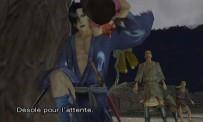 Unlike Astro Boy, another work by Tezuka adapted by Sega, Dororo is a manga with a context far too dark and gloomy for its video game version to adopt the original style full of charm, but also outdated, of the author. This is why the character design was entrusted to a fine blade, Horiaki Samura, author of The Inhabitant of Infinity (Casterman). The appearance of the monsters, another important point not to be overlooked, especially in the software that interests us here, is provided by Mahiro Maeda (Animatrix, Blue Submarine n°6). A major task, since monsters, the universe of Dororo, renamed Blood Will Tell in our latitudes, abounds in them. We find ourselves in the heart of feudal Japan, anchored in the harsh daily and social reality of that time, between hungry and oppressed peasants and tyrant and conquering lords. But above all, we are in the middle of a fantastical setting, in a land where monsters and spirits are not the prerogative of fairy tales, like this troll with a deformed skull, emerging from the fog to the sound of a bell ringing with each step. slow, disturbing your night under the stars, near a stream. Chilling and dark ambiance lovers, welcome to Blood Will Tell. RED Entertainment's game will retain its macabre hue and dark soundtrack throughout your journey, as an angry sky hovers above you, whose swirling clouds threaten to materialize in a maelstrom of bad feelings one of 48 Monsters, items from Hyakkimaru's insane quest.
Unlike Astro Boy, another work by Tezuka adapted by Sega, Dororo is a manga with a context far too dark and gloomy for its video game version to adopt the original style full of charm, but also outdated, of the author. This is why the character design was entrusted to a fine blade, Horiaki Samura, author of The Inhabitant of Infinity (Casterman). The appearance of the monsters, another important point not to be overlooked, especially in the software that interests us here, is provided by Mahiro Maeda (Animatrix, Blue Submarine n°6). A major task, since monsters, the universe of Dororo, renamed Blood Will Tell in our latitudes, abounds in them. We find ourselves in the heart of feudal Japan, anchored in the harsh daily and social reality of that time, between hungry and oppressed peasants and tyrant and conquering lords. But above all, we are in the middle of a fantastical setting, in a land where monsters and spirits are not the prerogative of fairy tales, like this troll with a deformed skull, emerging from the fog to the sound of a bell ringing with each step. slow, disturbing your night under the stars, near a stream. Chilling and dark ambiance lovers, welcome to Blood Will Tell. RED Entertainment's game will retain its macabre hue and dark soundtrack throughout your journey, as an angry sky hovers above you, whose swirling clouds threaten to materialize in a maelstrom of bad feelings one of 48 Monsters, items from Hyakkimaru's insane quest.
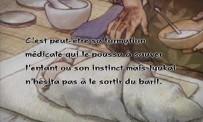 Hyakkimaru, child cursed at birth by a power-hungry father who involuntarily offered him as a sacrifice to a brotherhood of 48 Monsters. Hyakkimaru was not a stillborn child, but Lord Daigo, his father, had the unpleasant surprise to discover that his wife had given birth to a being whose 48 parts had been stolen by the Monsters. Abandoned to his fate, but recovered by a genius scientist, Hyakkimaru had an artificial body transplanted by his benefactor, Doctor Jyukai. The latter, will not stop there, and had an idea approved by many fans of action games. From a crippled child, Hyakkimaru became the greatest killing machine of all time, his arms containing two sharp blades, a gun, and his leg a bazooka. Just that ! Having become an adult, the young Hyakkimaru leaves for a quest whose objective is clear. He must find and eliminate the 48 Monsters, in order to recover his body parts and become the human being he was when he was born. A trained physician, Tezuka was acutely aware of the inconsistencies of a character living without their major organs, muscles, or bones, on a biological level. However, the master strived to make the human body the guinea pig of all his creative fantasies, as in one of his greatest successes, Black Jack. But back to our samurai in search of revenge and humanity.
Hyakkimaru, child cursed at birth by a power-hungry father who involuntarily offered him as a sacrifice to a brotherhood of 48 Monsters. Hyakkimaru was not a stillborn child, but Lord Daigo, his father, had the unpleasant surprise to discover that his wife had given birth to a being whose 48 parts had been stolen by the Monsters. Abandoned to his fate, but recovered by a genius scientist, Hyakkimaru had an artificial body transplanted by his benefactor, Doctor Jyukai. The latter, will not stop there, and had an idea approved by many fans of action games. From a crippled child, Hyakkimaru became the greatest killing machine of all time, his arms containing two sharp blades, a gun, and his leg a bazooka. Just that ! Having become an adult, the young Hyakkimaru leaves for a quest whose objective is clear. He must find and eliminate the 48 Monsters, in order to recover his body parts and become the human being he was when he was born. A trained physician, Tezuka was acutely aware of the inconsistencies of a character living without their major organs, muscles, or bones, on a biological level. However, the master strived to make the human body the guinea pig of all his creative fantasies, as in one of his greatest successes, Black Jack. But back to our samurai in search of revenge and humanity.
The samurai who was worth 3 billion
 Hyakkimaru's adventure is divided into chapters, like a manga. Seven more precisely, not to mention the prologue which familiarizes you with the controls of the game and with your unexpected traveling companion: the young thief Dororo. The progression of this action/adventure game is rather clever, since as Hyakkimaru overcomes a Monster, he will see his abilities improved according to the organ he will have received as a reward. And if necessary to obtain new skills. For example, the reception of his leg, made of flesh and blood, will allow you to sprint, while the whole part of the game taking place before having recovered the first of his two eyes will take place in black and white! You are warned "it's not a failure of your television", as the other said. Knowing that following the story line does not involve facing the 48 Monsters, it is up to the player to find the remaining creatures, after having finished the game for the first time, if he wishes. For it is only when the 48th of these horrors dies at the end of Hyakkimaru's blade that the young samurai's quest will be accomplished. To do this, Hyakkimaru has two evolving blades integrated into his arms, understand that the more you attack, the more they will increase in power, the same for the other sabers that you will find on the way. Hyakkimaru also has a spiritual attack, which can be used when the spirit gauge is full, and whose nature varies according to the scrolls you discover.
Hyakkimaru's adventure is divided into chapters, like a manga. Seven more precisely, not to mention the prologue which familiarizes you with the controls of the game and with your unexpected traveling companion: the young thief Dororo. The progression of this action/adventure game is rather clever, since as Hyakkimaru overcomes a Monster, he will see his abilities improved according to the organ he will have received as a reward. And if necessary to obtain new skills. For example, the reception of his leg, made of flesh and blood, will allow you to sprint, while the whole part of the game taking place before having recovered the first of his two eyes will take place in black and white! You are warned "it's not a failure of your television", as the other said. Knowing that following the story line does not involve facing the 48 Monsters, it is up to the player to find the remaining creatures, after having finished the game for the first time, if he wishes. For it is only when the 48th of these horrors dies at the end of Hyakkimaru's blade that the young samurai's quest will be accomplished. To do this, Hyakkimaru has two evolving blades integrated into his arms, understand that the more you attack, the more they will increase in power, the same for the other sabers that you will find on the way. Hyakkimaru also has a spiritual attack, which can be used when the spirit gauge is full, and whose nature varies according to the scrolls you discover.
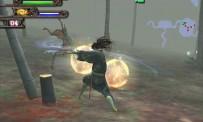 All this gives an evolutionary character specific to the RPG which is not unpleasant. For her part, Dororo has several throwing weapons, however less effective than a good close combat. From this point of view, we regret that the puny Dororo manages to eliminate, almost as easily as Hyakkimaru, all kinds of bloodthirsty demons using her little fists. One could have imagined two distinct types of gameplay between the phases of the samurai and those of the thief, as well as better complementarity. The two friends help each other, of course, but all the sequences are scripted in advance, the player does not have the opportunity to switch between the two characters whenever he wishes. This results in a fairly easy progression, which is not necessarily a bad thing for players who want to give pride of place to action rather than research. The puzzles are thus few and very simple, however the enemies will be legion on your way! That's good, Hyakkimaru proves, once all his skills in his pocket, of extraordinary efficiency. Rush against a troop of demons while slashing with aggressiveness and efficiency is child's play. The character responds very well to your requests, and turns out to be lively and fast, after a slight adaptation period. Only aiming with the cannon leg is all the more annoying as the ammunition is very limited. In addition, with only one bar of life at his disposal, we begin to be a little afraid in front of the flagrant lack of healing objects and other ammunition. In reality, the game is full of bonuses of this kind, but you have to get them by the sweat of your brow. Let me explain, Hyakkimaru has a special attack, by charging and releasing the triangle button, which allows you to start a series of combos in a limited time. Place a maximum of keys following the indications on the screen, completing it with the triangle button, and the enemy will disappear leaving behind him many portions of rice and other cannonballs. A technique that should not be overlooked, otherwise you will quickly find yourself disarmed in the face of the countless Bosses that dot the game.
All this gives an evolutionary character specific to the RPG which is not unpleasant. For her part, Dororo has several throwing weapons, however less effective than a good close combat. From this point of view, we regret that the puny Dororo manages to eliminate, almost as easily as Hyakkimaru, all kinds of bloodthirsty demons using her little fists. One could have imagined two distinct types of gameplay between the phases of the samurai and those of the thief, as well as better complementarity. The two friends help each other, of course, but all the sequences are scripted in advance, the player does not have the opportunity to switch between the two characters whenever he wishes. This results in a fairly easy progression, which is not necessarily a bad thing for players who want to give pride of place to action rather than research. The puzzles are thus few and very simple, however the enemies will be legion on your way! That's good, Hyakkimaru proves, once all his skills in his pocket, of extraordinary efficiency. Rush against a troop of demons while slashing with aggressiveness and efficiency is child's play. The character responds very well to your requests, and turns out to be lively and fast, after a slight adaptation period. Only aiming with the cannon leg is all the more annoying as the ammunition is very limited. In addition, with only one bar of life at his disposal, we begin to be a little afraid in front of the flagrant lack of healing objects and other ammunition. In reality, the game is full of bonuses of this kind, but you have to get them by the sweat of your brow. Let me explain, Hyakkimaru has a special attack, by charging and releasing the triangle button, which allows you to start a series of combos in a limited time. Place a maximum of keys following the indications on the screen, completing it with the triangle button, and the enemy will disappear leaving behind him many portions of rice and other cannonballs. A technique that should not be overlooked, otherwise you will quickly find yourself disarmed in the face of the countless Bosses that dot the game.
Plagues and Bosses
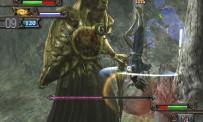 For that, if you like Bosses, you will be in heaven with Blood Will Tell. Between the dream-eating cyclops insect and the ogress in the kabuki mask, a pretty anthology of atrocities of all kinds is ready to receive you to make you drool. Often huge, they are truly a recurring element of Blood Will Tell. The confrontations are anticipated with anguish at the beginning, to give way to a certain routine at the end, the techniques to be used to overcome them being finally quite repetitive. A bit of cunning, playfulness, speed and anticipation, and it's in the pocket. With an ambitious program of 48 Monsters, it was to be expected a small drop in creativity, or simply a big laziness on the part of the programmers. It is therefore not surprising to come across, on several occasions, the twin brother of a monster shot down a few chapters earlier. In addition to the Bosses, you will regularly be confronted with human adversaries, whom Hyakkimaru, raised to respect his peers, refrains from killing. Consequently, no magic powers and other leg-bazookas that hold, you will have to act like a Kenshin Himura, hitting with the flat of your blade. And when the number of soldiers reaches 100, needless to say, endurance is put to the test. Often subject to criticism in 3D games, the camera only blurs for a few minutes, the time to take the reflex recenter it with L1. Knowing that certain portions of the game are played the Onimusha, to refer to a similar universe, ie with a camera with predefined viewing angles. Blood Will Tell enjoys, moreover, a technical realization which hesitates between the very aesthetic and the frankly average. The whole, without reaching peaks, remains very acceptable. Finally, a soundtrack of good quality ensures the title of RED Entertainment its status as an ambient game.
For that, if you like Bosses, you will be in heaven with Blood Will Tell. Between the dream-eating cyclops insect and the ogress in the kabuki mask, a pretty anthology of atrocities of all kinds is ready to receive you to make you drool. Often huge, they are truly a recurring element of Blood Will Tell. The confrontations are anticipated with anguish at the beginning, to give way to a certain routine at the end, the techniques to be used to overcome them being finally quite repetitive. A bit of cunning, playfulness, speed and anticipation, and it's in the pocket. With an ambitious program of 48 Monsters, it was to be expected a small drop in creativity, or simply a big laziness on the part of the programmers. It is therefore not surprising to come across, on several occasions, the twin brother of a monster shot down a few chapters earlier. In addition to the Bosses, you will regularly be confronted with human adversaries, whom Hyakkimaru, raised to respect his peers, refrains from killing. Consequently, no magic powers and other leg-bazookas that hold, you will have to act like a Kenshin Himura, hitting with the flat of your blade. And when the number of soldiers reaches 100, needless to say, endurance is put to the test. Often subject to criticism in 3D games, the camera only blurs for a few minutes, the time to take the reflex recenter it with L1. Knowing that certain portions of the game are played the Onimusha, to refer to a similar universe, ie with a camera with predefined viewing angles. Blood Will Tell enjoys, moreover, a technical realization which hesitates between the very aesthetic and the frankly average. The whole, without reaching peaks, remains very acceptable. Finally, a soundtrack of good quality ensures the title of RED Entertainment its status as an ambient game.
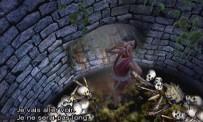 The seven chapters all offer a very satisfying scope of play and interesting level-design. To top off a very positive picture, the lifespan is significant for the genre, with around fifteen hours to overcome the adventure, if we do not try to flush out the 48 critters. Which gives a replay value of a few more hours if we want Hyakkimaru to finally find the peace he deserves, that is to say by eliminating the monsters to the last one. A challenge with particularly well balanced difficulty, closer to easy than to elitism at the Ninja Gaiden. In addition to an art gallery, a Dororo mode will be unlocked after completing the game. Moderately amusing, it puts the little one in the spotlight in series of time attacks where he must collect treasures in a given time.
The seven chapters all offer a very satisfying scope of play and interesting level-design. To top off a very positive picture, the lifespan is significant for the genre, with around fifteen hours to overcome the adventure, if we do not try to flush out the 48 critters. Which gives a replay value of a few more hours if we want Hyakkimaru to finally find the peace he deserves, that is to say by eliminating the monsters to the last one. A challenge with particularly well balanced difficulty, closer to easy than to elitism at the Ninja Gaiden. In addition to an art gallery, a Dororo mode will be unlocked after completing the game. Moderately amusing, it puts the little one in the spotlight in series of time attacks where he must collect treasures in a given time.
